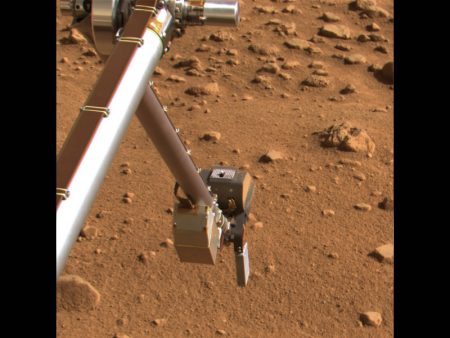July 10, 2017 – This is a good news, bad news story. The good news is any biology that hitchhikes on Mars landers and rovers probably stands no chance of survival on the surface of Mars today. The chemistry of the surface combined with cosmic ray exposure represents a double-edged sword to Earth-based life. But is that the case for life native to Mars should it exist?
In an article appearing in Scientific Reports on July 6, 2017, researchers at the University of Edinburgh describe experiments on Martian habitability. They combined the chemistry of the Martian regolith containing perchlorates, iron oxides, and hydrogen peroxide, with unrestricted ultraviolet radiation. The latter simulated the atmosphere’s inability to block such a cosmic ray bombardment.
Bacillus subtilis, an Eath bacteria, was then introduced into the environment, first without ultraviolet exposure, and later with exposure. The perchlorates combined with iron oxide and hydrogen peroxide produced on their own death within minutes for the bacterial sample. Then when ultraviolet radiation was simulated, the bacteria succumbed in half the time.
Since 1976 scientists have known of the presence of perchlorates in Mars’ surface soils. Both Viking 1 and 2 detected perchlorates, and based on some assessments, Martian life. At the time the controversy suggested life might very well thrive in a chlorine and oxygen charged environment. Then in 2008 the Phoenix lander reported finding perchlorates in more northerly latitudes. Phoenix measured the concentration in soil samples it collected which constituted between 0.4 and 0.6% of the total. This level of concentration in Martian regolith was not seen as a life deal breaker either and was a confirmation of the Viking results.
The added presence of unrestricted surface bombardment by ultraviolet light, however, according to the University of Edinburgh experiment, adds a more lethal dimension. That’s because when ultraviolet light strikes an object it heats it, and when you heat chlorine molecules in perchlorates they become highly disruptive to the cellular functions of Earth-based life. So that’s where we can derive good news. It makes it highly unlikely that Earth biology can stand up to the surface conditions of Mars. And that means any lander or rover sent to the Red Planet will not inadvertently introduce alien life.
But does it mean that Mars’ Earth-bacteriocidal surface environment is unreceptive to its own extremophiles which have evolved and adapted to the planet’s environment? And does it mean that bacteria similar to that found on Earth couldn’t reside underground shielded from the uninhabitability zone caused by the combination of soil chemistry and ultraviolet radiation? The answer to both of these questions is a very big unknown.
The answer to both these questions is a very big unknown.
The University of Edinburgh chose to use Bacillus subtilis, a common “garden variety” bacteria. They didn’t introduce any Earth-based extremophiles to see how they would cope. When asked about extremophiles’ chances, Jennifer Wadsworth, a co-author of the paper states, “it’s not out of the question that hardier life forms would find a way to survive.” Wadsworth further notes that it is unknown how deeply penetrating ithe uninhabitability zone is below the surface. Digging down a few meters may be the difference between death and life.
An expedition in 2020, the ExoMars rover, a joint effort by the European Space Agency and Roscosmos, incorporates a drill capable of reaching to 2 meters (6.5 feet) in depth. ExoMars hopes that the drill may yield evidence of Martian life. NASA’s Mars 2020 mission does not include a sampling drill on board. It intends to search for and obtain relevant samples of biosignatures from Mars’ geological past and present by analyzing objects on the surface.
















